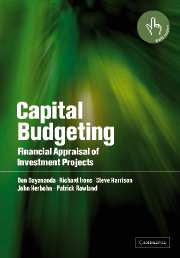Book contents
- Frontmatter
- Contents
- List of figures
- List of tables
- Preface
- 1 Capital budgeting: an overview
- 2 Project cash flows
- 3 Forecasting cash flows: quantitative techniques and routes
- 4 Forecasting cash flows: qualitative or judgemental techniques
- 5 Essential formulae in project appraisal
- 6 Project analysis under certainty
- 7 Project analysis under risk
- 8 Sensitivity and break-even analysis
- 9 Simulation concepts and methods
- 10 Case study in financial modelling and simulation of a forestry investment
- 11 Resource constraints and linear programming
- 12 More advanced linear programming concepts and methods
- 13 Financial modelling case study in forestry project evaluation
- 14 Property investment analysis
- 15 Forecasting and analysing risks in property investments
- 16 Multinational corporations and international project appraisal
- References
- Index
1 - Capital budgeting: an overview
Published online by Cambridge University Press: 14 May 2010
- Frontmatter
- Contents
- List of figures
- List of tables
- Preface
- 1 Capital budgeting: an overview
- 2 Project cash flows
- 3 Forecasting cash flows: quantitative techniques and routes
- 4 Forecasting cash flows: qualitative or judgemental techniques
- 5 Essential formulae in project appraisal
- 6 Project analysis under certainty
- 7 Project analysis under risk
- 8 Sensitivity and break-even analysis
- 9 Simulation concepts and methods
- 10 Case study in financial modelling and simulation of a forestry investment
- 11 Resource constraints and linear programming
- 12 More advanced linear programming concepts and methods
- 13 Financial modelling case study in forestry project evaluation
- 14 Property investment analysis
- 15 Forecasting and analysing risks in property investments
- 16 Multinational corporations and international project appraisal
- References
- Index
Summary
Financial management is largely concerned with financing, dividend and investment decisions of the firm with some overall goal in mind. Corporate finance theory has developed around a goal of maximizing the market value of the firm to its shareholders. This is also known as shareholder wealth maximization. Although various objectives or goals are possible in the field of finance, the most widely accepted objective for the firm is to maximize the value of the firm to its owners.
Financing decisions deal with the firm's optimal capital structure in terms of debt and equity. Dividend decisions relate to the form in which returns generated by the firm are passed on to equity-holders. Investment decisions deal with the way funds raised in financial markets are employed in productive activities to achieve the firm's overall goal; in other words, how much should be invested and what assets should be invested in. Throughout this book it is assumed that the objective of the investment or capital budgeting decision is to maximize the market value of the firm to its shareholders. The relationship between the firm's overall goal, financial management and capital budgeting is depicted in Figure 1.1. This self-explanatory chart helps the reader to easily visualize and retain a picture of the capital budgeting function within the broader perspective of corporate finance.
Funds are invested in both short-term and long-term assets. Capital budgeting is primarily concerned with sizable investments in long-term assets.
- Type
- Chapter
- Information
- Capital BudgetingFinancial Appraisal of Investment Projects, pp. 1 - 11Publisher: Cambridge University PressPrint publication year: 2002



